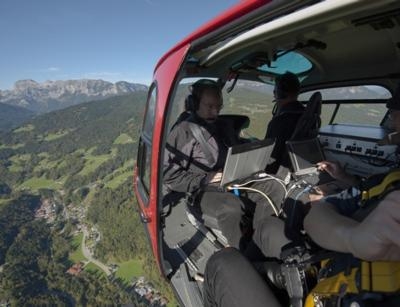Sat, Oct 27, 2012
Mission To Collect Data On How Two Different Systems Will Work Together
A helicopter recently flew over a very special Alpine valley to gather data on how Europe’s two satellite navigation systems – EGNOS and Galileo – will work together in future. The helicopter flew a variety of maneuvers, from fast loops to mid-air hovering, to see how satnav signals were received in practice. The results are now being analyzed.

The airborne testing, which took place in Germany in late September, was based around prototype signals of the next generation of the European Geostationary Navigation Overlay Service – EGNOS – combined with simulated Galileo signals. EGNOS, the first pan-European satellite navigation system, is based on U.S. GPS signals. The first four Galileo satellites have been placed in orbit – the minimum needed to provide basic navigational services. It will take many more to provide global coverage.
But there is one place in Europe where full Galileo service coverage is already a reality: the town of Berchtesgaden in the Bavarian Alps has transmitters atop eight neighbouring mountain peaks to blanket 65 sq km of territory with satnav signals. The result is the Galileo Test and Development Environment – GATE – a giant outdoor laboratory where prototype Galileo receivers can be used freely without any modifications.
Kept busy by European industrial and research teams, GATE is owned by the DLR German Aerospace Center. ESA’s Global Navigation Satellite Systems for Europe (GNSS) Evolution program uses it to help prepare the design of next-generation systems. The helicopter testing relied on the SPEED platform – Support Platform for EGNOS Evolutions & Demonstrations – enabling a user to receive simultaneous real-time augmentation signals for both GPS and Galileo, in the same way that the intended next-generation EGNOS system will operate.
The ESA-designed EGNOS employs a trio of satellites, processing facilities and a network of ground stations to improve the accuracy of GPS satnav signals over European territory. The service is guaranteed to an extremely high level of reliability set by the International Civil Aviation Organisation: it is allowed just a one in 10 million chance of error.

The satellite-based service provides horizontal and vertical guidance information for aircraft performing safety-critical landing approaches to airports in a similar way to existing Instrument Landing System devices – but with no local ground-based navigation infrastructure needed. “EGNOS is already certified for European aviation but what we are testing here is how it operates with Galileo,” explained Guenter Hein, head of ESA’s GNSS Evolution program. "We are seeking to develop the next generation of EGNOS, which should be ready and operational around 2020. The ambition for Europe is to have an EGNOS-like system able to manage the data coming from both Galileo and GPS, making the system much more robust. It will be an important part of a constellation of EGNOS-like satellite augmentation systems covering our entire planet.”
GNSS Evolution is also tasked with designing the next generation of more advanced Galileo satellites, proceeding on the basis that the first generation of satellites will need replacement in the course of the 2020s.
(Image provided by ESA)
More News
Also: SkyReach Parts Support, Piper Service Ctr, Airliner Near-Miss, Airshow London The Judge overseeing Icon's convoluted Chapter 11 process has approved $9 million in Chapter 11 >[...]
ILS PRM Approach An instrument landing system (ILS) approach conducted to parallel runways whose extended centerlines are separated by less than 4,300 feet and at least 3,000 feet >[...]
Aero Linx: FlyPups FlyPups transports dogs from desperate situations to fosters, no-kill shelters, and fur-ever homes. We deliver trained dogs to veterans for service and companion>[...]
Also: Skydio Chief, Uncle Sam Sues, Dash 7 magniX, OR UAS Accelerator US Secretary of the Air Force Frank Kendall was given a turn around the patch in the 'X-62A Variable In-flight>[...]
Also: NBAA on FAA Reauth, DJI AG Drones, HI Insurance Bill Defeated, SPSA Airtankers The Beechcraft Denali continues moving forward towards certification, having received its FAA T>[...]
 Airborne 05.10.24: Icon Auction, Drunk MedEvac Pilot, Bell ALFA
Airborne 05.10.24: Icon Auction, Drunk MedEvac Pilot, Bell ALFA ANN's Daily Aero-Term (05.13.24): ILS PRM Approach
ANN's Daily Aero-Term (05.13.24): ILS PRM Approach ANN's Daily Aero-Linx (05.13.24)
ANN's Daily Aero-Linx (05.13.24) Airborne-NextGen 05.07.24: AI-Piloted F-16, AgEagle, 1st 2 WorldView Sats
Airborne-NextGen 05.07.24: AI-Piloted F-16, AgEagle, 1st 2 WorldView Sats Airborne 05.08.24: Denali Update, Dad-Daughter Gyro, Lake SAIB
Airborne 05.08.24: Denali Update, Dad-Daughter Gyro, Lake SAIB




